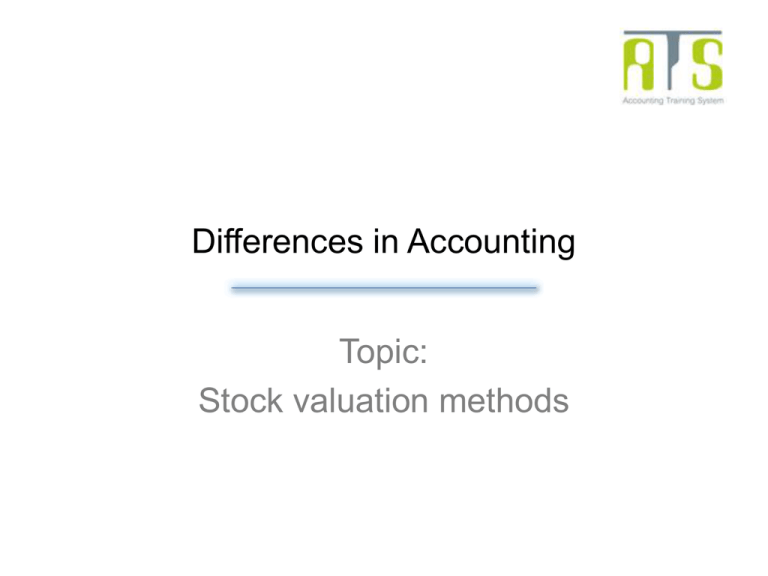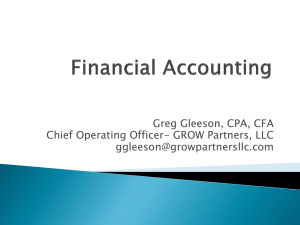Differences in Accounting
advertisement

Differences in Accounting Topic: Stock valuation methods Overview: Valuation of stocks Methods: Fifo, Identical (you must use it if it´s possible), weighed average Methods : Fifo, Lifo, weighed average Methods : Fifo, Identical (you must use it if it´s possible), weighed average Methods : Lifo, Hifo, Lofo, Kifo Methods : Fifo, Identical (you must use it if it´s possible), weighed average, Lifo Methods : Fifo, weighed average, Identical (you must use it if it´s possible), Lifo, FIFO and weighed average (AVCO) IFRS IAS 2 Inventories. Specific indentification. FIFO or average cost formulas. Details Austria • Do you have "valuation at the lower of cost principle"? Yes if the value of an inventory piece decreases under the market price you have to take the lower one. • How do you calculate the costs of goods sold? Every sales transaction or once a year? During the year we book all purchases to an expense account and we book the adjustment once a year. • Which valuation methods are allowed for valuation of the stock? identical or average or FiFo. If the identical method is possible we must use it. • Is a perpetual inventory allowed? Is it necessary to make a physical inventory count? A perpetual inventory is allowed if you have an inventory management system. • How do treat the inventory variance (like theft or breakage) ? We book it to a special expense account. • How are finished goods or goods in process valuated ? cost of goods manufactured without imputed costs Details Denmark • Do you have "valuation at the lower of cost principle"? Always cost price. • How do you calculate the costs of goods sold? Every sales transaction or once a year? Either every sales transaction or once a year depending on the ICT system . • Which valuation methods are allowed for valuation of the stock? The FIFO-method for inventory statement can be accepted. The LIFO-method can however not be accepted for the assessment of the inventory • Is a perpetual inventory allowed? Is it necessary to make a physical inventory count? Yes. • How do treat the inventory variance (like theft or breakage) ? We book it to a depeciation account. • How are finished goods or goods in process valuated ? to cost price Details Germany • Do you have "valuation at the lower of cost principle"? Yes if the devaluation is permanent • How do you calculate the costs of goods sold? Every sales transaction or once a year? During the year we book all purchases to an expense account and we book the adjustment once a year. • Which valuation methods are allowed for valuation of the stock? Only average method or LiFo and no FiFo. • Is a perpetual inventory allowed? Is it necessary to make a physical inventory count? A perpetual inventory is allowed if you have an inventory management system. • How do treat the inventory variance (like theft or breakage) ? We book it to a special expense account. • How are finished goods or goods in process valuated ? cost of goods manufactured without imputed costs Details Estonia • Do you have "valuation at the lower of cost principle"? Inventories shall be measured in the balance sheet at the lower of cost or net realisable value. • How do you calculate the costs of goods sold? Every sales transaction or once a year? Usually we have perpetual inventory system, it means we show at the same time cost of goods sold and sales revenue. If enterprises use periodic inventory system, the cost of goods sold is calculated • Which valuation methods are allowed for valuation of the stock? Specific identification, FIFO, weighed average. Is a perpetual inventory allowed? Is it necessary to make a physical inventory count? Perpetual inventory system is allowed. It is necessary to have a physical inventory under both methods (periodic and perpetual system). • • How do treat the inventory variance (like theft or breakage) ? It is treated as expense. • How are finished goods or goods in process valuated ? As the other items of inventories Details Finland • Do you have "valuation at the lower of cost principle"? The lower of cost. • How do you calculate the costs of goods sold? Every sales transaction or once a year? Every sales transactions • Which valuation methods are allowed for valuation of the stock? We will value by using FIFO, LIFO, identical or average…, many possibilities are aloud. For same stock we use the same method. Is a perpetual inventory allowed? Is it necessary to make a physical inventory count? Perpetual inventory system is allowed. It is necessary to have a physical inventory under both methods (periodic and perpetual system). • • How do treat the inventory variance (like theft or breakage) ? We correct the value of stock in our bookkeeping by these variances. • How are finished goods or goods in process valuated ? Variable costs or variable costs + fixed costs (of manufactured goods). Details Hungary • Do you have "valuation at the lower of cost principle"? Yes if the value of an inventory piece decreases under the market price you have to take the lower one. • How do you calculate the costs of goods sold? Every sales transaction or once a year? 2 possibilities: First to inventory and then to expenses or immediately to purchase expenses. • Which valuation methods are allowed for valuation of the stock? Average method or FiFo. • Is a perpetual inventory allowed? Is it necessary to make a physical inventory count? A perpetual inventory is allowed if you have an inventory management system. • How do treat the inventory variance (like theft or breakage) ? We book it to a special expense account. • How are finished goods or goods in process valuated ? cost of goods manufactured without imputed costs Details UK • Do you have "valuation at the lower of cost principle"? We value the stock at the lower of cost or net realisable value. • How do you calculate the costs of goods sold? Every sales transaction or once a year? Sales + Closing Stock – Less Opening Stock. • Which valuation methods are allowed for valuation of the stock? LIFO, FIFO and AVCO (see following pages). • Is a perpetual inventory allowed? Is it necessary to make a physical inventory count? A perpetual inventory is allowed if you have an inventory management system . • How do treat the inventory variance (like theft or breakage) ? We post it to a special expense account . • How are finished goods or goods in process valuated ? Cost of goods manufactured Stock Valuation Methods United Kingdom FIFO First In – First Out International Accounting Standards no longer permit the use of the last in – first out (LIFO) method of determining the valuation of stock. IAS 2 will allow the continued use of first in – first out (FIFO) and of the average cost method (AVCO) Some inventories do not fall into IAS 2. These include agricultural products after harvest and mineral products which are measured at net realisable value. What is FIFO ? This is the most common method of determining stock valuation. It makes the assumption that the first stock received will be the first that is sold. Older stocks are assumed to be sold before the most recent stock. The stock valuation then is made on only the most recent stock. Choosing a Method Once a method for stock valuation has been selected a business should continue to use that method unless there is a very good reason to change the method. This is an example of the consistency concept in accounting. An example of stock valuation Sue’s Bookstore is making a stock valuation for the title “Accounting Concepts and Principles” In week 1 she bought 100 copies at £2-00 and sold 80 copies at £3-50p In week 2 she bought 200 copies at £2-10 and sold 160 copies at £3-75 What is the value of her stock at the end of week 2 ? Finding the solution FIFO She has purchased 300 copies of the book, 100 in week 1 and 200 in week 2. She has sold 240 copies of the book. At the end of week 2 she has 60 copies left. These books are from the batch purchased in week 2 at £210p. Her stock is valued at 60 x £2-10. This amounts to £126-00 What is AVCO ? The average cost of the items purchased is calculated at the end of the period. When new stocks are received then a new average cost must be calculated. An example of stock valuation Sue’s Bookstore is making a stock valuation for the title “Accounting Concepts and Principles” In week 1 she bought 100 copies at £2-00 and sold 80 copies at £3-50p In week 2 she bought 200 copies at £2-10 and sold 160 copies at £3-75 What is the value of her stock at the end of week 2 ? Finding the solution AVCO • At the end of week 1 there are 20 books in stock purchased at £2-00. These are valued at £40-00 • At the start of week 2 there are 200 books valued at £420-00 • This makes a total of 220 books costing £46000. • This is an average of £2-09 (to the nearest penny) Finding the solution 2 • There are 60 books left at the end of week 2 • These are valued at £2-09 each • This gives a stock valuation of £125-40 Net Realisable Value Suppose the stock is valued and then the owner of the business realises that the goods cannot be sold for that price. Stock should be valued at the lower of cost and net realisable value. This is an example of the prudence concept in accounting. An example of stock valuation Sue’s Bookstore is making a stock valuation for the title “Accounting Concepts and Principles” In week 1 she bought 100 copies at £2-00 and sold 80 copies at £3-50p In week 2 she bought 200 copies at £2-10 and sold 160 copies at £3-75 At the end of week 4 she is left with 60 books which she expects to be able to sell at £1-75 each. Value of her books • • • • There are 60 books left Each is valued at £1-75. The total value of the stock is 60 x £1-75. The value is £105-00. Details IFRS • Do you have "valuation at the lower of cost or market principle"? In accordance with IAS 2: Generally inventories (stocks) are measured at the lower of cost and net realisable value. If the net realisable value of an item that has been written down subsequently increases, then the write-down is reversed. • • Which valuation methods are allowed for valuation of the stocks? In accordance with IAS 2: When items of inventories (stocks) are not interchangeable, cost is determined on a individual basis. A cost formula may be used when there are many interchangeable items. The cost formula used should be FIFO or weighted average cost. Other cost formulas, such as the standard cost or retailed method, may be used when the result approximate actual cost.








